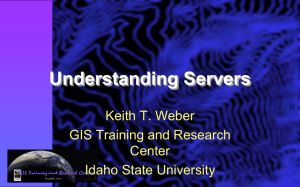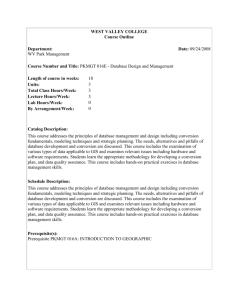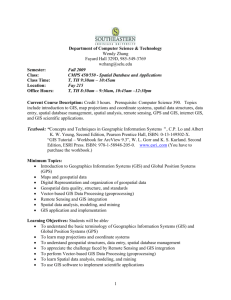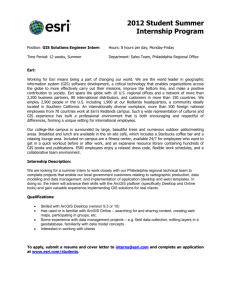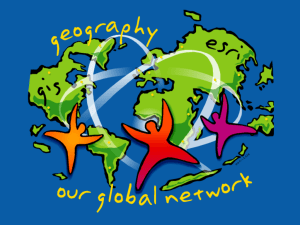instructor - University of Redlands
advertisement
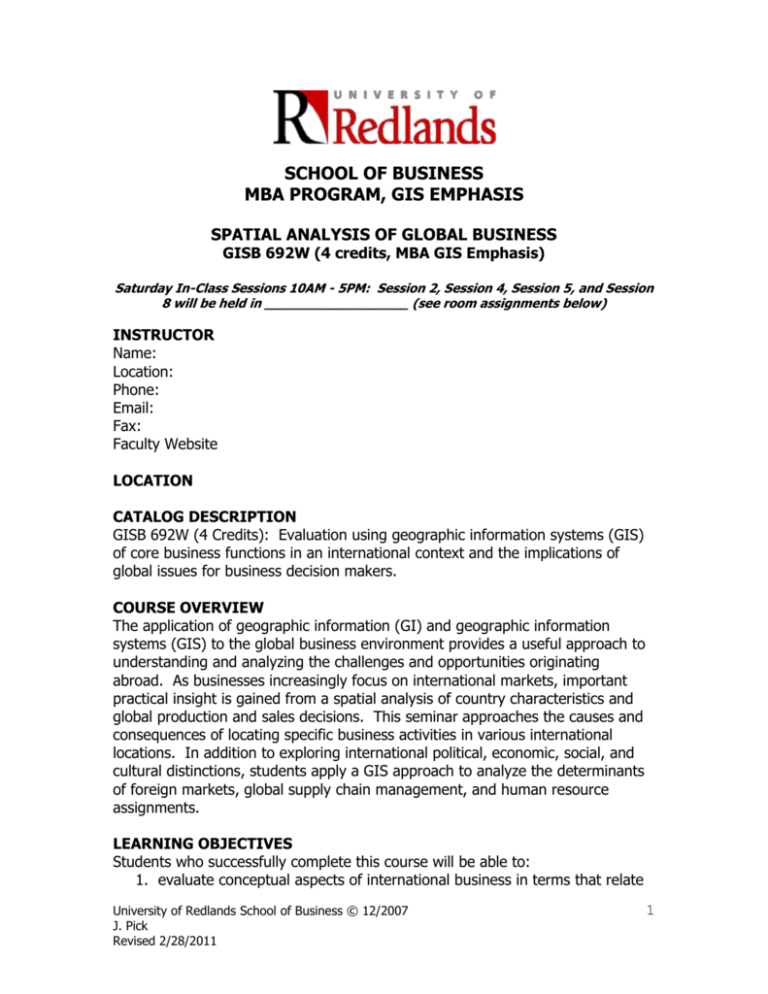
SCHOOL OF BUSINESS MBA PROGRAM, GIS EMPHASIS SPATIAL ANALYSIS OF GLOBAL BUSINESS GISB 692W (4 credits, MBA GIS Emphasis) Saturday In-Class Sessions 10AM - 5PM: Session 2, Session 4, Session 5, and Session 8 will be held in __________________ (see room assignments below) INSTRUCTOR Name: Location: Phone: Email: Fax: Faculty Website LOCATION CATALOG DESCRIPTION GISB 692W (4 Credits): Evaluation using geographic information systems (GIS) of core business functions in an international context and the implications of global issues for business decision makers. COURSE OVERVIEW The application of geographic information (GI) and geographic information systems (GIS) to the global business environment provides a useful approach to understanding and analyzing the challenges and opportunities originating abroad. As businesses increasingly focus on international markets, important practical insight is gained from a spatial analysis of country characteristics and global production and sales decisions. This seminar approaches the causes and consequences of locating specific business activities in various international locations. In addition to exploring international political, economic, social, and cultural distinctions, students apply a GIS approach to analyze the determinants of foreign markets, global supply chain management, and human resource assignments. LEARNING OBJECTIVES Students who successfully complete this course will be able to: 1. evaluate conceptual aspects of international business in terms that relate University of Redlands School of Business © 12/2007 J. Pick Revised 2/28/2011 1 2. 3. 4. 5. 6. the importance of spatial considerations to business decisions in the international context use GI and GIS to analyze the distinctions and similarities between domestic and international business environments and the effect of globalization on each understand the spatial dimensions and determinants of worldwide manufacturing propose and implement international business strategies using GIS as a foundation for evaluating the steps to and consequences of entering international markets analyze international governance organizations and their impact on global business integrate the functional areas of business with effective use of GIS that responds to the challenges inherent in international business MAJOR TOPICS GIS and the conceptual aspects of international trade and FDI Role and influence of international organizations Influence of population, resources, and environment on global business Doing business across cultures Operational environments in international business GIS assessment industry sectors in the international environment GIS and global sourcing and supply chains Understanding and analysis of global governance organizations Imports and exports GIS analysis of international human resource issues Financial forces influencing international business Doling business in the developing world TEXT Dicken, P. (2010). The global shift. (6th ed.). The Guilford Press. ISBN 13: 978-1609180065 RECOMMENDED SUPPLEMENTAL TEXT (optional) Stutz, F. P. & Warf, B. (2011). The world economy: Geography, business, development. Upper Saddle River, New Jersey: Prentice Hall. ISBN 978-0321740441. RECOMMENDED READINGS The Economist, Wall Street Journal, (both available on Proquest), The Information Society (available on FirstSearch), Financial Times, Los Angeles Times, New York Times, Harvard Business Review (available on EBSCO Business Source Elite), Directions Magazine (covers GIS in business topics) University of Redlands School of Business © 12/2007 J. Pick Revised 2/28/2011 2 COURSE OBLIGATIONS/ASSIGNMENTS In addition to completing the assigned readings, this online-enhanced course will employ online threaded discussions and a series of GIS data analysis exercises to assess student learning. To facilitate student interaction and incorporate Blackboard course site capabilities, four Saturday sessions will be held in weeks 2, 4, 5, and 8. Class discussion of reading assignments Your principal reading obligation is to keep up with the assigned chapters within the course study outline contained in this syllabus. In addition, you are asked to follow current international economic/business issues reported by the press. Class attendance on the four Saturday sessions is expected and participation (individually and in groups) will be evaluated on its contribution to the learning process. Online discussions To encourage student reflection and interaction in this online-enhanced course, students will participate in four online discussions. Topics and length of discussion periods will be posted on the course Blackboard site. Student contributions will be assessed based on their ability to address the issues presented and engage fellow students in a thoughtful progression of ideas based on GIS concepts. Online Discussion 1 (due for Session 2) To encourage student reflection at the beginning of this eight week course, students will participate in an online discussion of the spatial influence of global resources on international business. Students will read Chapter 10 in the Greene/Pick textbook Exploring the Urban Community: A GIS Approach, 2nd ed. The chapters are posted on Blackboard. In Chap. 10 of the textbook, there is a section 10.7 on “Energy” on pp. 330-336. In addition, a number of links to websites and .pdf files available in the syllabus and posted on Blackboard that have further information on the world spatial distributions of fossil fuels. One that is recommended is BP’s Statistical Review of World Energy 2006. Fossil fuels distribution and production are very timely in the current news, stemming from issues and questions of political stability in producer nations particularly the situation of democratic upsurge in Libya, the Gulf Oil Spill in 2010, which influence pricing and policies of producer nations. This is a required on-line discussion in which you explain in at least 250 words how the recent trends and changes in global fossil fuel resource distributions, flows, and pricing influence a company you are familiar with. Companies to consider are airlines, rental car companies, trucking firms, utility firms, metal manufacturers, hotels in certain climate locations, etc. Please indicate the location of the firm – in the U.S. or in a country overseas. Then in another 250University of Redlands School of Business © 12/2007 J. Pick Revised 2/28/2011 3 word post, make some comparison of your post with someone else’s post. Market analysis (due for Session 3) You will select three countries and use internet data and map service tools to assess which foreign market offers the best potential for successful marketing of one of the following products: home air conditioners, high-end men’s briefcases, or moderate-priced European-style toys. Papers should follow a clear screening process that considers country needs as well as the political, economic, legal, and cultural considerations specific to that country. This exercise promotes the student’s ability to incorporate GIS and international statistical data to propose and implement international business decisions that incorporate the steps to and consequences of entering international markets. This exercise is due for Session 4. Manufacturing Industry Analysis (due for Session 4) For an industry of interest to you, research and define the worldwide spatial distribution, flows, and clustering. Do not duplicate an industry already covered in Dicken, but pick a different one. The industry cluster can be global, national, or regional. Access the electronic journals available on-line from the Armacost Library or other library resources. Your 4 to 5-page report should include the following: A definition of the spatial extent of the industry A description of the types of related industries associated with the primary industry An understanding of how the industry might be organized in terms of inter-industry linkages, supply chains, trade flows, access to common facilities and resources, etc. The purpose of this assignment is for the student to demonstrate the use of Dicken’s theories in the analysis of a particular manufacturing industry including its spatial distribution and flows. Online Discussion 2 (due for Session 5). Discussion of three cases from J. Pick, Geo-Business: GIS in the Digital Organization (John Wiley and Sons, 2008). The three international cases are available for download from Blackboard. The instructor will provide this specific assignment include the discussion objectives. The cases are Norwich Union (UK), Enmax (Canada), and Seaspan (Canada). Report on World Governance Organization (due for Session 6) University of Redlands School of Business © 12/2007 J. Pick Revised 2/28/2011 4 In this 3-page report, based on pp. 537-550 Chapter 17 in Dicken, you will select an international governance, regulatory, environmental, or financial organization such as the WTO, IMF, World Bank, UN, or IPCC. You will describe the organization, its history, current organization and functioning, goals, and performance for the past 5-10 years. Be sure to mention how the organization is arranged spatially with respect to the locations of its services and populations served. Is it truly worldwide, or does it focus more on serving certain world regions or nations? The ultimate objective of the report is to support an argument whether, in Dicken’s Chap. 17 terminology, the organization makes the world a “better place.” You should consult at least 2 other sources. The report is 2-3 pages. Expatriate Selection Assignment (due for Session 7). The final exercise requires students to use GIS tools to examine and select a two-year overseas posting for themselves. Students will assess the human resource characteristics of various locations to determine a placement that best suits their career objectives. For country data, you are advised to start with the websites recommended and branch out. Examples of attributes you might consider are availability of schooling, crime rates, income per capita, business environment, standard of living, and safety. Students must support this 5-page report by producing one ArcGIS map and one map from a web service such as www.worldmapper.org , www.gapminder.org , or any website that provides maps. To insert a web map, first do a screen shot of the map (Cntr Alt PrtScn) and then Paste it into your report. Be sure to give a source citation. The ArcGIS map can be produced from the ESRI Mapping and Data files available in the Jones Center, from the downloadable data from the ESRI website, much of which is available in ArcGIS 10, or from other sources you may be familiar with. For the ArcGIS map, you can use the ArcGIS’s drawing features to add additional notation and highlighting of your paper points. You can then export this map in .jpg format (File/Export Map/Save As Type/JPEG) and insert the .jpg into your report. This analysis is due for Session 7, with initial draft(s) due (for instructor comment) via e-mail on the Friday before Session 7. For the initial draft, you are not required to include the maps. However, for the final paper for Session 7 you will need to include your 2 maps. You’ll also give a short presentation on your expatriate report in class on this day. Online Discussion 3 (due for Session 8). Small group discussion of one of the supply chain readings for Week 7, i.e. the Gershenhorn, Liker/Choi, or Regmi/Gehlhar article. In an annotated Powerpoint posting, indicate what is global about this supply chain situation. What do you University of Redlands School of Business © 12/2007 J. Pick Revised 2/28/2011 5 think is the most important lesson from this article for international supply chain decision-making? Do you have suggestions on how the supply chain(s) discussed can be improved? How can this reading be related to spatial concepts? Post your ideas as an annotated Powerpoint file of 10 slides or less. Use Powerpoint’s Note section to elaborate on each slide. Be visual in your powerpoint. Use diagrams and, optionally, put a map or two in the slides. The supply chain readings, which are available as .pdf files on Blackboard, are: Gershenhorn, A. (2004). “The Making of a Successful Global Supply Chain.” World Trade 17(12):19-22. Liker, J.K. and Choi, T.Y. (2004) “Building Deeper Supplier Relationships.” Harvard Business Review, December 2004. Regmi, A. and Gehlhar, M. (2005) “Processed Food Trade Pressured by Evolving Global Supply Chains.” Amber Waves. Feb. Vol 3(1):12-19. There are some web links in the resource section of the syllabus that provide background on the concepts of supply chain, which are not covered in the Dicken textbook. GIS Emphasis Reflective Learning Journal (due for Session 8, April 30) The GIS Emphasis Reflective Learning Journal is a three-page reflection at the end of this course on what you think makes businesses and organizations ready or well suited to utilize a geographical information system to support global business decision making. Please think about what conditions and readiness factors are necessary for an organization to obtain benefit through using geographic information and applying GIS. Please include at least a half a page of this journal considering this potential global business use of GIS in the context of the developing world. Please write this in an essay format, explaining why certain readiness factors are important. Do not submit a list without explanation. GRADE WEIGHTINGS Final grades will be based on the following weighted factors. Assignment Due at Session Percentage Online Discussions 2, 5, 8 9 In-class GIS Lab Exercises 2, 4, 5 6 Market Analysis 3 15 Manufacturing Industry Analysis 4 12 University of Redlands School of Business © 12/2007 J. Pick Revised 2/28/2011 6 Report on World Governance Organization Expatriate Selection Assignment Global Supply Chain Spatial Design Reflective Learning Journal Participation TOTAL 6 7 8 8 University of Redlands School of Business © 12/2007 J. Pick Revised 2/28/2011 10 20 15 5 All 8 100% 7 NUMBER/LETTER GRADING RELATIONSHIP 4.0 A 93% - 100% 2.0 3.7 A90% - 92% 1.7 3.3 B+ 88% - 89% 1.3 3.0 B 83% - 87% 1.0 2.7 B80% - 82% 0.7 2.3 C+ 78% - 79% 60% 0.0 C CD+ D D- 73% 70% 68% 63% 60% F - 77% 72% 69% 67% 62% below GRADING CRITERIA The nature of the written and oral assignments in this course is such that the quality of student work may only be assessed through subjective evaluation. However, certain criteria will guide the instructor’s judgment. Therefore, all assignments will be evaluated on evidence of learning, depth of analysis, organization and thoroughness as well as the ability to anticipate the regulatory/policy forces affecting business. Assignments should demonstrate that you have analyzed the key issues in the course and text, and are thinking critically about the policy context of business. Assignments should be logically presented, adequately supported, and carefully reasoned. All written assignments should be typed, double-spaced and contain a bibliography of cited sources and appropriate footnotes. All ideas, quotes and statistics borrowed from another author must be cited. If you did not collect the data to support your position, then you need to properly cite the authority that did. Evidence of individual contribution to group projects will be gauged through the student's effectiveness and participation in class discussion of the project. The general evaluation criteria are more fully stated as follows: 4.0 or 3.7 (A): Outstanding. The student displayed exceptional grasp of the material, frequently with evidence of intellectual insight and original thought. 3.3 or 3.0 (B): Excellent. Work demonstrated a thorough grasp of the material with occasional errors and omissions. Assignments were thoroughly and completely done, with careful attention to detail and clarity and with evidence of intellectual insight. 2.7, 2.3, or 2.0 (B-, C): Acceptable. The quality of work was acceptable, meeting minimal course standards, but was not exceptional. Performance on examinations and other assignments was satisfactory and demonstrated that the student was keeping up with the material and attending to detail. University of Redlands School of Business © 12/2007 J. Pick Revised 2/28/2011 8 Graduate students will not receive credit for a course awarded a grade of 1.7 or below. A cumulative grade point average below 3.0 is not sufficient for good standing in graduate programs. (C-, D, F) 1.7, 1.3, 1.0, 0.7. 0.0 Unacceptable for graduate credit. I W Incomplete. With a valid excuse, an incomplete will be given. Consult the U of R Catalog for further information on incomplete grades. Withdraw. Student officially withdraws from the class. If instructor is not informed about withdrawal from the course, an F will be assigned on the grade sheet. GRADE OF “INCOMPLETE” An “incomplete” is not given for poor or neglected work. A grade of “incomplete” is to be granted only for very special reasons and should occur only after a discussion between faculty and student, initiated by the student. The decision of whether or not to grant an incomplete is dependent on an emergency situation that prevents the student from completing (on time) the work necessary for the course. An incomplete grade will be converted to a permanent grade within eight weeks from the last night of the course. This means that the instructor must turn in the grade to the Registrar no later than the eighth week. Any incomplete work must be submitted to the instructor with enough lead time for the instructor to evaluate the work and issue a grade change. See U of R catalog for further guidance. ATTENDANCE Because of the applied and varied material to be covered in this online-enhanced class, it is important that you keep up with online assignments and come well prepared to the two in-class sessions. Students are responsible for all information given during the class instruction. If a student misses more than an hour of inclass instruction, a make-up assignment will be required and incorporated in the participation grade. Students missing one class will need to make arrangements with the instructor for special make-up work. See the instructor for the assignment. Unexcused absences will adversely affect your grade. Unexcused absences are those which are not cleared with the instructor before the class and/or are for reasons other than an emergency. Students missing more than one in-class session will not receive credit for the course. TIME MANAGEMENT Each 4-credit (Carnegie Unit) graduate course is the equivalent of 180 hours. This online-enhanced course centers on four 6-hour Saturday sessions held throughout the eight-week course period. Alternate weeks are comprised of online activities University of Redlands School of Business © 12/2007 J. Pick Revised 2/28/2011 9 and instruction. Although the amount of time that you spend studying may depend upon the topic, a student should expect to spend an average of 20.5 hours per week. The text assignment will average 150 pages weekly, which translates to approximately 10-12 hours of study time. That will leave about 8-10 hours per week to review online notes, work on GIS analysis exercises, participate in online discussion, and visit the instructor online with your questions. DISABLED STUDENT SERVICES A student with a documented disability who wishes to request an accommodation should contact the staff at his/her campus or the Disabled Student Services Office on the main campus at (909) 748-8108. ACADEMIC HONESTY The University of Redlands Policy on Academic Honesty will be strictly adhered to and applied. The Procedures for Addressing Academic Honesty are set forth in the University of Redlands Catalog. It is expected that all students read and understand the Policy and the provisions outlined in the Catalog. The highest standards of academic conduct are required. This is particularly true for the proper citation of course and research material in all written assignments. If you did not actually collect the data or independently arrive at the idea presented, then a proper citation must be used. Citations (in the form of parenthetical notes, endnotes or footnotes) must be used for quoted or paraphrased text and any time you borrow an idea from an author, the instructor, or your peers. Using someone else’s sentence or organizational structure, pattern of argument and word choice, even if not exactly similar in every respect, warrants citation. It is students’ responsibility to make sure that their citations and quotation marks unambiguously highlight the ideas, words, sentences, and arguments that they borrow from other sources. Paraphrasing is not simply changing one or two words in a sentence; it completely reconstructs someone else’s idea in your own words. For guidelines on appropriate citation, quotation, paraphrasing, and plagiarism, see materials provided by the Indiana University’s Writing Tutorial Center at http://www.indiana.edu/~wts/pamphlets/plagiarism.shtml and Harvard University’s Expository Writing Program at http://www.fas.harvard.edu/~wricntr/resources.html Discussion with the instructor and your peers is encouraged before the composition of written work; however, all written work, unless specified by the instructor, is to reflect independent composition and revision. Students working on group or collaborative assignments are expected to contribute equally to all University of Redlands School of Business © 12/2007 J. Pick Revised 2/28/2011 10 tasks necessary for completion of the assignment. Students are expected to follow all written and verbal instructions provided by the instructor with regard to written assignments, quizzes and/or exams. In addition to plagiarism, other impermissible academic behavior includes, but is not limited to, collaboration without instructor consent, falsifying research data, illicit possession of exams, using study aids during exams, unauthorized communication about an assignment or exam, handing in others’ work as your own, reusing assignments or papers from other courses, and impeding equal access to educational resources by other students. Time constraints, the demands of work and family, failing to read the University’s Policy on Academic Honesty, unintentional misuse of sources, or a lack of preparation do not excuse academic dishonesty or otherwise mitigate the appropriate penalty. Penalty for a first offense is at the discretion of the instructor. If a student is uncertain about appropriate methods of citation or has a question about the academic honesty policy, it is his or her responsibility to seek guidance from the instructor, a University official, or another reputable source. LATE ASSIGNMENTS Assignments submitted late will be downgraded at the rate of 2% for each calendar day of delay. Assignments are due via email by 11:59pm of the due date posted to Blackboard. POLICY FOR CELL PHONES AND LAPTOPS IN THE CLASSROOM Cell phones will be off or on vibrate during all class sessions (excluding the dinner break) to avoid distractions. Students should refrain from making or taking non-critical personal or business cell phone calls during class sessions. If a phone call must be taken, the student will exit the classroom. Laptop use during class is limited to taking notes related to the lecture or class discussions and/or researching material directly requested by the instructor. Internet searches will not be used to support discussions or interaction during class time unless specifically requested by the instructor. Students will not use cell phones and/or laptops to surf the web, play games, read or generate personal or business email, or text others in class or outside of class for any reason during class time. Students in violation of this policy may be asked to leave the classroom. University of Redlands School of Business © 12/2007 J. Pick Revised 2/28/2011 11 COURSE SCHEDULE Segment Session 1 March 12 Reading Topics The Global Economy Technological Change Dicken Chps 1, 2, 3 - Shifts in the Global Economy Dicken Chp 15 – Environmental Impacts (online) Greene and Pick Chp 10. Environmental Problems (note: this reading from Activities Online discussion of impact of global fossil fuel flows (occurs between pre-course and up to Session 2) Exploring the Urban Community: A GIS Approach, 2nd ed., R. Greene and J. Pick (Prentice Hall, 2012) is available on Blackboard under “Course Readings and External Links”). Introd. to course Session 2 March 19 In-class Introd. to spatial analysis for global business Population, Global Cities, and Global Business: Spatial Aspects Dicken Chp 4 Technological Change Dicken Chp 16 Economic Development, Poverty, Population Case study on international economic migration. ArcGIS Lab 1 Exercise (inclass). The exercise focuses on the comparison of petroleum and population distributions in Asia and Europe. ArcGIS Lab Exercise on Asia-Europe Petroleum and Population Transnational Corporations Session 3 March 26 (online) International Trade and investment: Spatial Aspects Discussion of students’ Market Analysis Exercise Demo of The Geography Network and other free online map services Case Study of Mexican Tourism in the Global Context Session 4 April 2 In-class Dicken Chp 5 – Transnational Corporations Dicken Chp 6 - The Role of the State in the Global Economy Dicken Chp 7 – Bargaining Process between States and Transnational Corporations Readings, 3 cases from J. Pick, GeoBusiness (Wiley, 2008). Posted on Blackboard. Cases are Norwich Union (UK), Enmax (Canada), and Seaspan (Canada) Environment for International Business. Dicken Chp. 8 – Extractive Industries Global Manufacturing Dicken Chp 10 – Clothing Global Logistics and Distribution Dicken Chp 9 – Agro-Food Dicken Chp 11 -- Automobiles Dicken Chp 13 – Logistics, Distribution Session 5 April 9 In-class Global Agricultural business Cities and Urban Economies Readings (TBA) on cities and urban economies Discussion – export of U.S fast food globally April 16 (online) Global Financial Services Role and Influence of International Organizations Governance Organizations for the Global Economy -Manufacturing industry analysis ArcGIS Lab 2 Exercise (inclass). The exercise focuses on the global distribution of indicators of internet usage and growth. Online discussion of three cases due (discussion between Session 4 and 5) ArcGIS Lab 3 Exercise (inclass). The exercise focuses on China’s urban agglomerations. ArcGIS Lab on Global Internet Usage and Growth Session 6 -Market analysis exercise due Dicken Chp 12 – Financial and other Business Services - Report on world governance organization due Dicken Chp. 17 – Making the World a Better Place ArcGIS Lab Exercise (TBA) University of Redlands School of Business © 12/2007 J. Pick Revised 2/28/2011 12 Global Production Networks Session 7 Supply Chains Dicken Chap 14 Capturing Value Within Transnational Production Networks Readings (pick one of the three). April 23 Gershenhorn, A. (2004). “The Making of a Successful Global Supply Chain.” World Trade 17(12):19-22. (online) Liker, J.K.and Choi, T.Y. (2004) “Building Deeper Supplier Relationships.” Harvard Business Review, December. Session 8 April 17 In-class The Developing World International Business in the Developing World -Online discussion board (provide PowerPoint to the discussion board on one of the 3 articles). Occurs after session 7. Google Earth in-class exercise on economic impact of distribution of Chinese cities Regmi, A. and Gehlhar, M. (2005). “Processed Food Trade Pressured by Evolving Global Supply Chains.” Amber Waves 3(1):12-19. Expatriate selection assignment due Reading TBA – Development and Underdevelopment in the Developing World GIS Supply chain spatial designs due Reflective Learning Journal The schedule may be changed depending on class requirements. University of Redlands School of Business © 12/2007 J. Pick Revised 2/28/2011 13 References: Ball, Donald A., Wendell H.McCulloch, Paul L. Frantz, J. Michael Geringer, and Michael Minor. 2004. International Business: The Challenge of Global Competition. 9th Edition. Boston: Irwin McGraw Hill. Boyles, D. 2002. GIS Means Business, Volume 2. Redlands, CA: ESRI Press. Greene, Richard P. and James B. Pick. 2006. Exploring the Urban Community: A GIS Approach. Upper Saddle River, New Jersey: Prentice Hall. Hill, Charles L. 2003. International Business: Competing in the Global Marketplace. 4th edition. New York: McGraw Hill. Krugman, Paul, and Maurice Obstfeld. 2002. International Economics: Theory and Practice. 6th edition. New York: Addison Wesley. Pick, James B. (ed.). 2005. Geographic Information Systems in Business. Hershey, PA: Idea Group Publishing. Pick, James B. 2008. Geo-Business: GIS in the Digital Organization. New York: John Wiley and Sons. Thrall, G. 2002. Business Geography and the New Real Estate Analysis. New York: Oxford University Press. World Bank. 2006. WDI (World Development Indicators) Online. Washington, D.C.: World Bank. (Contains a wealth of data from 1960-2002 on countries and country groups worldwise including economic, financial, social and other data.). Available as the following UofR electronic library source on-campus only: World Development Indicators Online (WDI) Website links - general: http://www.census.gov/ipc/www/idbpyr.html U.S. Census International Programs Center (IPC). Population age pyramids for nations worldwide for 2000, 2025, and 2050. http://www.census.gov/ipc/www U.S. Census International Programs Center (IPC) The International Data Base (IDB) contains summary demographic data for nations worldwide. Includes population projections to 2025 and population age pyramids 2005 and 2025. http://www.cia.gov/cia/publications/factbook The World Factbook of the CIA (contains some maps and a large data-base of social, economic, and governmental data for nations worldwide. http://www.geographynetwork.com The Geography Network (contains a wealth of map and attribute data) University of Redlands School of Business © 12/2007 J. Pick Revised 2/28/2011 14 http://www.progress.org/econolink/ EconoLink Best Web Sites (compendium of on-line economics sites) http://www.intute.ac.uk/socialsciences Intute Social Science Information Gateway. Contains wealth of social science information. Based in the UK, but has worldwide data. For this course, the sections on Business and Management, and Economics are the most useful. Take a peek at Geography also. http://rfe.org Resources for Economists on the Internet (large set of internet resources on economics including spatial and mapping ones) http://www.socialexplorer.com It “provides easy access to demographic information about the United States. We provide thousands of interactive data maps going back to 1790.” (Social Explorer, 2011). Fossil fuel Websites (for pre-week Discussion Board) http://www.bp.com/genericsection.do?categoryId=92&contentId=7005893 BP’s Statistical Review of World Energy 2006. Many color maps, charts, and tables. http://certmapper.cr.usgs.gov/rooms1.1/we/index.jsp?maxx=180.0&maxy=90.0&minx= -180.0&miny=-90.0&service=country World Energy Assessment from U.S Geological Survey. Click on “use map.” Click on a country on the world map and it will give you the sources of energy information for the country. http://www.eia.doe.gov/oiaf/ieo/index.html International Energy Outlook 2006 from U.S. Energy Information Administration. By clicking on the cover image, you can obtain all or part of this report in .pdf format. Lots of data and graphs, but not maps. http://pubs.usgs.gov/dds/dds-060 World Petroleum Assessment 2000 from U.S. Geological Survey. U.S. Geological Survey world assessment and maps of undiscovered petroleum reserves. Clicking on “World Maps” gives a limited set of maps. More extensive maps and data are in the .pdf file for Chapter AR (“Analysis of Assessment Results”). http://www.eia.doe.gov/emeu/security/oilflow2.gif Map of world oil flows 1997 from U.S. Energy Information Administration. References – fossil fuels “Who produces what.” New Statesman, Dec. 10, 2001. Map of key world areas of oil production. Available on Proquest. Country Websites (for Session 3 and Session 4 papers) University of Redlands School of Business © 12/2007 J. Pick Revised 2/28/2011 15 https://www.cia.gov/cia/publications/factbook/index.html CIA World Factbook. Contains a general map of nearly all countries worldwide and a variety of social, economic, and political data. The rank order of the country can be compared through worldwide look-up tables that are readily available. http://devdata.worldbank.org/data-query World Bank World Development Indicators – Data Query. This allows you to examine a sample of data from the World Development Indicators in a format that allows you to display tables, export to Excel, or convert to charts. Includes data on 54 variables over the five years 1999 to 2003 for 208 nations and 18 groups of nations. If you export into Excel, you can make further calculations in Excel and use its graphing features. http://www.state.gov/r/pa/ei/bgn U.S. Department of State Background Notes. Includes facts on countries worldwide concerning “land, people, history, government, political conditions, economy, and foreign relations.” Country orientation maps are available. http://www.imf.org/external/country/index.htm#R International Monetary Fund Country Information. For nearly all nations, gives access to a variety of country reports, documents, and press releases from the IMF, covering economics, finance, business climate, and social and political environment. http://www.oecd.org/countrieslist/0,3025,en_33873108_33844430_1_1_1_1_1,00.html OECD (Organization for Economic Cooperation and Development). Contains a wealth of data on 33 advanced nations, plus the aggregated European Community. A wealth of statistical tables are available on all the OECD nations by clicking on the left of the entry screen on “Statistics.” http://unstats.un.org/unsd/mi/mi.asp United Nations Statistics Division. Millennium Indicators Database. This gives 48 key social and economic indicators by nations worldwide over the past 15 years. Click to the left under “Data” and “Country level data” to get the data. You can also find here MDGInfo 2006, a database that is available online for free (you need to register). It corresponds to the Millennium Development Goals Report 2006. There is a wealth of other development data about countries as well. Other UN Sites http://unstats.un.org/unsd/economic_main.htm Economic statistics http://unstats.un.org/unsd/demographic Demographic and social statistics http://unstats.un.org/unsd/environment_main.htm Environmental and energy statistics Online Map Data (for Session 3 or Session 4 Paper) http://www.lib.utexas.edu/maps University of Texas Austin Perry Castañeda Map University of Redlands School of Business © 12/2007 J. Pick Revised 2/28/2011 16 Collection. This is a collection of online maps worldwide. They are downloadable as map images, but not in digital form for mapping in ArcGIS. If you use them, be sure to cite. http://www.geographynetwork.com The Geography Network www.worldmapper.com World Mapper A variety of world and national maps from commercial sources www.gapminder.org Remarkable summary graphs and maps on world development trends Map Services (for Session 3 or Session 4 Paper) http://www.geographynetwork.com The Geography Network (content type: “live data and maps”) Downloadable Map Data (for Session 3 or Session 4 Paper) http://www.esri.com/data/download/index.html ESRI Downloadable Data for ArcGIS (content type: “downloadable data”) Background on Supply Chain – Reference Powerpoint from Wharton/MIT (for Week 6 Powerpoint posting) A Powerpoint from Professor Marshall Fisher of Wharton and David Simchi-Levi of MIT on “Supply Chain Management” http://www.eleechina.com/wpaper/The_Supply_Chain.pdf University of Redlands School of Business © 12/2007 J. Pick Revised 2/28/2011 17



